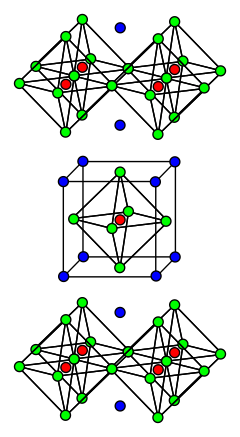Strontium ruthenate
 The unit cell of the layered perovskite structure of strontium ruthenate. Ruthenium ions are red, strontium ions are blue, and oxygen ions are green.
|
|
| Properties | |
|---|---|
| Sr2RuO4 | |
|
Except where otherwise noted, data are given for materials in their standard state (at 25 °C [77 °F], 100 kPa).
|
|
| Infobox references | |
Strontium ruthenate (SRO) is an oxide of strontium and ruthenium with the chemical formula Sr2RuO4. It was the first reported perovskite superconductor that did not contain copper. Strontium ruthenate is structurally very similar to the high-temperature cuprate superconductors, and in particular, is almost identical to the lanthanum doped superconductor (La, Sr)2CuO4. However, the transition temperature for the superconducting phase transition is 0.93 K, which is much lower than the corresponding value for cuprates.
High-quality crystals of strontium ruthenate are synthesized using a floating zone method in a controlled atmosphere with ruthenium as flux. The perovskite structure can be deduced based on powder x-ray diffraction measurements. Strontium ruthenate behaves as a conventional Fermi liquid at temperatures below 25 K.
Superconductivity in SRO was first observed by Yoshiteru Maeno and his group in 1994 when they were looking for high temperature superconductors with structures similar to the cuprates. Unlike the cuprates, SRO displays superconductivity even in the absence of doping. The superconducting order parameter in SRO has been shown to exhibit signatures of time-reversal symmetry breaking, and hence, it can be classified as an unconventional superconductor.
Sr2RuO4 is believed to be a fairly two-dimensional system, with superconductivity occurring primarily on the Ru-O plane. The electronic structure of Sr2RuO4 is characterized by three bands derived from the Ru t2g 4d orbitals, namely, α, β and γ bands, of which the first is hole-like while the other two are electron-like. Among them, the γ band arises mainly from the dxy orbital, while the α and β bands emerge from the hybridization of dxz and yz orbitals. Due to the two-dimensionality of Sr2RuO4, its Fermi surface consists of three nearly two-dimensional sheets with little dispersion along the crystalline c-axis and that the compound is nearly magnetic.
...
Wikipedia
